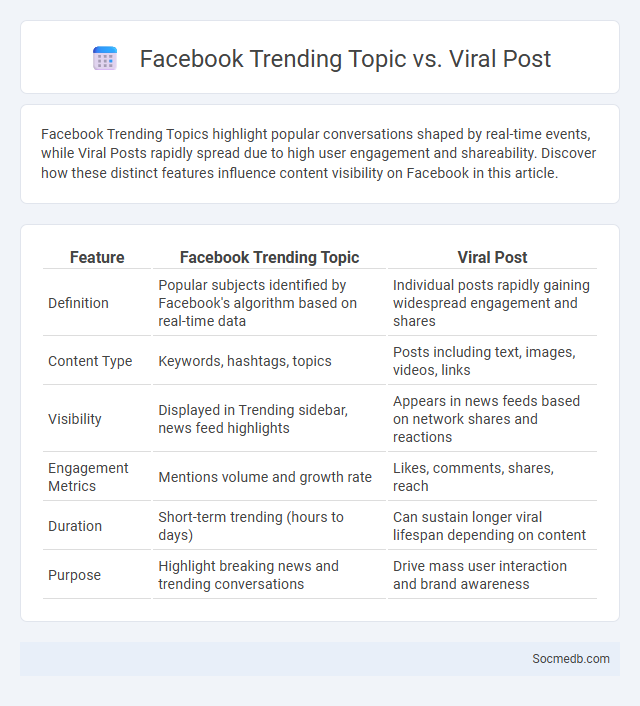
Photo illustration: Facebook Trending Topic vs Viral Post
Facebook Trending Topics highlight popular conversations shaped by real-time events, while Viral Posts rapidly spread due to high user engagement and shareability. Discover how these distinct features influence content visibility on Facebook in this article.
Table of Comparison
| Feature | Facebook Trending Topic | Viral Post |
|---|---|---|
| Definition | Popular subjects identified by Facebook's algorithm based on real-time data | Individual posts rapidly gaining widespread engagement and shares |
| Content Type | Keywords, hashtags, topics | Posts including text, images, videos, links |
| Visibility | Displayed in Trending sidebar, news feed highlights | Appears in news feeds based on network shares and reactions |
| Engagement Metrics | Mentions volume and growth rate | Likes, comments, shares, reach |
| Duration | Short-term trending (hours to days) | Can sustain longer viral lifespan depending on content |
| Purpose | Highlight breaking news and trending conversations | Drive mass user interaction and brand awareness |
Understanding Facebook Trending Topic
Facebook Trending Topics highlight the most popular and current conversations across the platform, driven by user interactions, shares, and comments. These trends are powered by complex algorithms that analyze real-time data to surface content relevant to Your interests and location. Understanding these trends allows marketers and users to engage with timely discussions and optimize content for maximum reach and impact.
What Makes a Post Go Viral on Facebook
Engaging content that sparks emotion and encourages interaction is crucial for a Facebook post to go viral. Your post should include high-quality visuals, concise text, and a clear call to action to maximize shares and comments. Algorithms prioritize posts with rapid engagement, so timing and relevance to trending topics also significantly boost visibility.
Defining “Trending” in the Context of Social Media
Trending in social media refers to the rapid and widespread popularity of topics, hashtags, or content that captures significant user engagement within a specific timeframe. Algorithms analyze metrics such as shares, comments, likes, and mentions to identify and promote these trends, ensuring your content reaches a broader audience quickly. Recognizing what is trending allows you to create relevant and timely posts that resonate with current conversations and user interests.
Key Differences: Trending Topic vs Viral Post
Trending topics on social media represent subjects or hashtags rapidly gaining widespread attention across numerous users and platforms, reflecting collective interest or breaking news at a given moment. Viral posts, on the other hand, are individual pieces of content, such as videos or images, that experience exponential sharing and engagement, often driven by emotional resonance or uniqueness. Your understanding of these distinctions enables strategic content creation, maximizing reach and engagement by aligning with either broad trending conversations or crafting shareable viral moments.
Algorithms Behind Facebook Trends
Facebook trends are driven by complex machine learning algorithms that analyze user engagement, content relevance, and real-time interactions to surface popular topics. These algorithms prioritize posts based on factors like user preferences, post popularity, and network activity to ensure Your feed displays the most relevant and trending content. Understanding these mechanisms can help You optimize content visibility and leverage trends for greater social media impact.
Factors Driving a Facebook Post to Virality
Engaging content that resonates emotionally and encourages user interaction significantly drives a Facebook post to virality. Strategic use of hashtags, compelling visuals, and timely posting during peak user activity enhance visibility and shareability. Algorithms prioritize posts with high engagement rates, amplifying their reach across networks and contributing to viral potential.
The Role of Hashtags and Engagement
Hashtags play a crucial role in increasing the visibility and reach of your social media posts by categorizing content and connecting it to trending topics and communities. Engaging with your audience through likes, comments, and shares enhances algorithmic favorability, boosting your content's exposure. Effective use of hashtags combined with active engagement drives brand awareness and fosters a loyal online community.
Measuring the Impact: Trend vs Virality
Measuring the impact of social media content requires distinguishing between trends and virality, as trends often indicate sustained user engagement over time while virality reflects rapid, short-term spikes in attention. Analytical tools track metrics such as share velocity, reach, and engagement rate to evaluate whether a topic is developing into a lasting trend or experiencing transient virality. Brands leverage these insights to optimize content strategies by targeting high-impact trends for long-term growth and using viral moments for immediate visibility boosts.
Case Studies: Viral Posts & Trending Topics
Analyzing viral posts reveals patterns in content engagement, such as emotional triggers and timely relevance, driving rapid sharing across platforms like Instagram and Twitter. Trending topics often emerge from a combination of influencer participation and real-time events, amplifying visibility exponentially. Case studies highlight how brands leverage hashtags and multimedia elements to sustain momentum and boost organic reach effectively.
Optimizing Content for Trends and Virality on Facebook
Optimizing content for trends and virality on Facebook requires leveraging real-time data insights and audience behavior analytics to craft engaging posts that resonate with popular topics. Your content should incorporate trending hashtags, relevant multimedia, and interactive elements like polls or questions to boost engagement and shareability. By aligning your posts with current viral themes and user preferences, you can significantly enhance reach and foster organic growth.
 socmedb.com
socmedb.com